Optimization and Characterization of Phenolic Extraction Conditions and Antioxidant Activity Evaluation of Adenanthera pavonina L. Bark
Abstract
:1. Introduction
2. Results and Discussion
2.1. Impact of Various Extraction Solvents on TPC and Antioxidant Activity
2.2. Optimization through Response Surface Methodology (RSM) Model
2.2.1. Effects of Operational Parameters on TPC Extraction and IC50 of Extract’s DPPH Radical Scavenging Activity
2.2.2. Optimization and Validation of the Extraction Process
2.3. Identification and Quantification of Phenolic Compounds
3. Materials
3.1. Plant Collection and Sample Preparation
3.2. Chemicals and Software
4. Methods
4.1. Solvent Extraction
4.2. Total Phenolic Content (TPC) Determination
4.3. Determination of Antioxidant Activities (DPPH Radical Scavenging Method)
4.4. Selection of Relevant Variables and Experiment Design
4.5. Estimation of Phenolic Compounds via High-Performance Liquid Chromatography (HPLC)
5. Conclusions
Author Contributions
Funding
Data Availability Statement
Acknowledgments
Conflicts of Interest
References
- Kirtikar, K.R.; Basu, B.D. Indian Medicinal Plants, 2nd ed.; Lalit Mohan Basu: Allahabad, India, 1991; pp. 909–910. [Google Scholar]
- Gerona, M.S.; Melo, R.C.; Barros, H.L.M.; Aquino, S.R.; Islam, M.T.; dos Santos Rizzo, M.; da Costa, M.P. Advances in the research of Adenanthera pavonina: From traditional use to intellectual property. J. Med. Plant Res. 2020, 14, 24–53. [Google Scholar] [CrossRef]
- Partha, G.; Rahaman, C.H. Pharmacognostic, phytochemical and antioxidant studies of Adenantherapavonina L. Int. J. Pharmacogn. Phytochem. Res. 2015, 7, 30–37. [Google Scholar]
- Dash, S.; Das, C.; Sahoo, D.C. Phytochemical and anthelmintic screening of crude bark extract of Adenanthera pavonina Linn. Pharm. Glob. Int. J. Compr. Pharm. 2010, 1, 1–4. [Google Scholar]
- Ara, A.; Arifuzzaman, M.; Ghosh, C.K.; Hashem, M.A.; Ahmad, M.U.; Bachar, S.C.; Nahar, L.; Sarker, S.D. Anti-inflammatory activity of Adenanthera pavonina L., Fabaceae, in experimental animals. Rev. Bras. Farmacogn. 2010, 20, 929–932. [Google Scholar] [CrossRef]
- Olajide, O.A.; Echianu, C.A.; Adedapo, A.D.; Makinde, J.M. Anti-inflammatory studies on Adenanthera pavonina seed extract. Inflammopharmacology 2004, 12, 196–201. [Google Scholar] [CrossRef] [PubMed]
- Ara, A.; Saleh-E-In, M.M.; Hashem, M.A.; Ahmad, M.; Hasan, C.M. Phytoconstituents of Adenanthera pavonina Linn from the bark extracts. Beni-Suef Univ. J. Basic Appl. Sci. 2019, 8, 20. [Google Scholar] [CrossRef]
- Owoeye, T.F.; Akinlabu, K.D.; Ajani, O.O. Proximate composition, phytochemical screening and mineral content studies of leaves extract of Adenanthera pavonina. Arab J. Basic Appl. Sci. 2023, 30, 317–328. [Google Scholar] [CrossRef]
- Krishnan, H.B.; Kim, S.; Pereira, A.E.; Jurkevich, A.; Hibbard, B.E. Adenanthera pavonina, a potential plant-based protein resource: Seed protein composition and immunohistochemical localization of trypsin inhibitors. Food Chem. 2022, 14, 100253. [Google Scholar] [CrossRef] [PubMed]
- Zeid, A.H.A.; El-Kashoury, E.A.; Sleem, A.A.; Waly, D.A. Lipoidal content and anti-inflammatory activity of Adenanthera pavonina L. leaves. J. Appl. Sci. Res. 2012, 8, 207–214. [Google Scholar]
- Silva, I.K.; Soysa, P. Evaluation of phytochemical composition and antioxidant capacity of a decoction containing Adenanthera pavonina L.; Thespesia populnea L. Pharmacogn. Mag. 2011, 7, 193–199. [Google Scholar] [CrossRef]
- Mohamed, S.M.; Hassanein, E.H.; Ross, S.A.; Mohamed, N.M. Phytoconstituents from Adenanthera pavonina L. as antioxidants and inhibitors of inducible TNF-α production in BV2 cells. Nat. Prod. Res. 2022, 36, 6267–6278. [Google Scholar] [CrossRef] [PubMed]
- Begum, S.N.; Ray, A.S.; Rahaman, C.H. A comprehensive and systematic review on potential anticancer activities of eugenol: From pre-clinical evidence to molecular mechanisms of action. Phytomedicine 2022, 107, 154456. [Google Scholar] [CrossRef]
- Fratta Pasini, A.M.; Cominacini, L. Potential Benefits of Antioxidant Phytochemicals on Endogenous Antioxidants Defences in Chronic Diseases. Antioxidants 2023, 12, 890. [Google Scholar] [CrossRef] [PubMed]
- Kumar, N.; Goel, N. Phenolic acids: Natural versatile molecules with promising therapeutic applications. Biotechnol. Rep. 2019, 24, e00370. [Google Scholar] [CrossRef]
- Stevenson, D.E.; Hurst, R.D. Polyphenolic phytochemicals–just antioxidants or much more? Cell. Mol. Life Sci. 2007, 64, 2900–2916. [Google Scholar] [CrossRef]
- Lobo, V.; Patil, A.; Phatak, A.; Chandra, N. Free radicals, antioxidants and functional foods: Impact on human health. Pharmacogn. Rev. 2010, 4, 118–126. [Google Scholar] [CrossRef]
- Mukherjee, S.; Mandal, N.; Dey, A.; Mondal, B. An approach towards optimization of the extraction of polyphenolic antioxidants from ginger (Zingiber officinale). J. Food Sci. Technol. 2014, 51, 3301–3308. [Google Scholar] [CrossRef] [PubMed]
- Gil-Martín, E.; Forbes-Hernández, T.; Romero, A.; Cianciosi, D.; Giampieri, F.; Battino, M. Influence of the extraction method on the recovery of bioactive phenolic compounds from food industry by-products. Food Chem. 2022, 378, 1–398. [Google Scholar] [CrossRef]
- Hazra, S.; Ray, A.S.; Das, S.; Das Gupta, A.; Rahaman, C.H. Phytochemical Profiling, Biological Activities, and In Silico Molecular Docking Studies of Causonis trifolia (L.) Mabb. & J. Wen Shoot. Plants 2023, 28, 5163. [Google Scholar] [CrossRef]
- Box, G.E.; Wilson, K.B. On the experimental attainment of optimum conditions. In Breakthroughs in Statistics: Methodology and Distribution; Kotz, S., Johnson, N.L., Eds.; Springer: New York, NY, USA, 1992; Volume 2, pp. 270–310. [Google Scholar] [CrossRef]
- Muala, W.C.B.; Desobgo, Z.S.C.; Jong, N.E. Optimization of extraction conditions of phenolic compounds from Cymbopogon citratus and evaluation of phenolics and aroma profiles of extract. Heliyon 2021, 7, e06744. [Google Scholar] [CrossRef]
- Kruk, J.; Aboul-Enein, B.H.; Duchnik, E.; Marchlewicz, M. Antioxidative properties of phenolic compounds and their effect on oxidative stress induced by severe physical exercise. J. Physiol. Sci. 2022, 72, 19. [Google Scholar] [CrossRef] [PubMed]
- Adnan, M.; Oh, K.K.; Azad, M.O.K.; Shin, M.H.; Wang, M.-H.; Cho, D.H. Kenaf (Hibiscus cannabinus L.) Leaves and Seed as a Potential Source of the Bioactive Compounds: Effects of Various Extraction Solvents on Biological Properties. Life 2020, 10, 223. [Google Scholar] [CrossRef] [PubMed]
- Altemimi, A.; Lakhssassi, N.; Baharlouei, A.; Watson, D.G.; Lightfoot, D.A. Phytochemicals: Extraction, isolation, and identification of bioactive compounds from plant extracts. Plants 2017, 6, 42. [Google Scholar] [CrossRef] [PubMed]
- Adnan, M.; Chy, M.N.U.; Kamal, A.T.M.M.; Chowdhury, K.A.A.; Rahman, M.A.; Reza, A.S.M.A.; Moniruzzaman, M.; Rony, S.R.; Nasrin, M.S.; Azad, M.O.K.; et al. Intervention in Neuropsychiatric Disorders by Suppressing Inflammatory and Oxidative Stress Signal and Exploration of In Silico Studies for Potential Lead Compounds from Holigarna caustica (Dennst.) Oken leaves. Biomolecules 2020, 10, 561. [Google Scholar] [CrossRef]
- Loganayaki, N.; Siddhuraju, P.; Manian, S. Antioxidant activity and free radical scavenging capacity of phenolic extracts from Helicteresisora L.; Ceiba pentandra L. J. Food Sci. Technol. 2013, 50, 687–695. [Google Scholar] [CrossRef]
- Adnan, M.; Chy, M.N.U.; Rudra, S.; Tahamina, A.; Das, R.; Tanim, M.A.H.; Siddique, T.I.; Hoque, A.; Tasnim, S.M.; Paul, A.; et al. Evaluation of Bonamia semidigyna (Roxb.) for antioxidant, antibacterial, anthelmintic and cytotoxic properties with the involvement of polyphenols. Orient. Pharm. Exp. Med. 2019, 19, 187–199. [Google Scholar] [CrossRef]
- Anderson, M.J.; Whitcomb, P.J. RSM Simplified: Optimizing Processes Using Response Surface Methods for Design of Experiments, 2nd ed.; Productivity Press: New York, NY, USA, 2016. [Google Scholar] [CrossRef]
- Nikaeen, G.; Yousefinejad, S.; Rahmdel, S.; Samari, F.; Mahdavinia, S. Central Composite Design for Optimizing the Biosynthesis of Silver Nanoparticles using Plantago major Extract and Investigating Antibacterial, Antifungal and Antioxidant Activity. Sci. Rep. 2020, 10, 9642. [Google Scholar] [CrossRef] [PubMed]
- Montgomery, D.C. Design and Analysis of Experiments, 7th ed.; John Wiley & Sons, Inc.: New York, NY, USA, 2009. [Google Scholar]
- Liyana-Pathirana, C.; Shahidi, F. Optimization of extraction of phenolic compounds from wheat using response surface methodology. Food Chem. 2005, 93, 47–56. [Google Scholar] [CrossRef]
- Jaafar, N.F.; Ramli, M.E.; Salleh, R.M. Optimum extraction condition of Clitoreaternatea flower on antioxidant activities, total phenolic, total flavonoid and total anthocyanin contents. Trop. Life Sci. Res. 2020, 31, 1–17. [Google Scholar] [CrossRef]
- Che Sulaiman, I.S.; Basri, M.; Fard Masoumi, H.R.; Chee, W.J.; Ashari, S.E.; Ismail, M. Effects of temperature, time, and solvent ratio on the extraction of phenolic compounds and the anti-radical activity of Clinacanthus nutans Lindau leaves by response surface methodology. Chem. Cent. J. 2017, 11, 1–11. [Google Scholar] [CrossRef]
- Jahromi, S.G. Extraction techniques of phenolic compounds from plants. In Plant Physiological Aspects of Phenolic Compounds; IntechOpen: London, UK, 2019; pp. 1–18. [Google Scholar] [CrossRef]
- Shi, L.; Zhao, W.; Yang, Z.; Subbiah, V.; Suleria, H.A.R. Extraction and characterization of phenolic compounds and their potential antioxidant activities. Environ. Sci. Pollut. Res. Int. 2022, 29, 81112–81129. [Google Scholar] [CrossRef]
- Robards, K. Strategies for the determination of bioactive phenols in plants, fruit and vegetables. J. Chromatogr. A 2003, 1000, 657–691. [Google Scholar] [CrossRef]
- Khoddami, A.; Wilkes, M.A.; Roberts, T.H. Techniques for analysis of plant phenolic compounds. Molecules 2013, 18, 2328–2375. [Google Scholar] [CrossRef] [PubMed]
- Hamad, A.; Hartanti, D. Effects of extraction time on total phenolic and flavonoid contents and antioxidant activities of a polyherbal drink. IOP Conf. Ser. Earth Environ. Sci. 2023, 1200, 1–8. [Google Scholar] [CrossRef]
- Sik, B.; Ajtony, Z.; Lakatos, E.; Székelyhidi, R. The effects of extraction conditions on the antioxidant activities, total polyphenol and monomer anthocyanin contents of six edible fruits growing wild in Hungary. Heliyon 2022, 8, 1–8. [Google Scholar] [CrossRef] [PubMed]
- Zimare, S.B.; Mankar, G.D.; Barmukh, R.B. Optimization of ultrasound-assisted extraction of total phenolics and flavonoids from the leaves of Lobelia nicotianifolia and their radical scavenging potential. Curr. Res. Green Sustain. Chem. 2021, 4, 1–10. [Google Scholar] [CrossRef]
- Patil, S.S.; Deshannavar, U.B.; Ramasamy, M.; Emani, S.; Khalilpoor, N.; Issakhov, A. Study of extraction kinetics of Total polyphenols from curry leaves. Int. J. Chem. Eng. 2021, 1–8. [Google Scholar] [CrossRef]
- Al-Juhaimi, F.; Adiamo, O.Q.; Ghafoor, K.; Babiker, E.E. Optimization of ultrasonic-assisted extraction of phenolic compounds from fenugreek (Trigonella foenum-graecum L.) seed. CyTA-J. Food 2016, 14, 369–374. [Google Scholar]
- Rodrigo, S.K.; Jayasingha, U.L.B.; Bandara, B.M.R. Antifungal, antioxidant and cytotoxic activity of Acronychia pedunculata and Adenanthera pavonina. Proc. Perad. Univ. Res. Sess.-Sri Lanka 2007, 12, 94–95. [Google Scholar]
- Naveed, M.; Hejazi, V.; Abbas, M.; Kamboh, A.A.; Khan, G.J.; Shumzaid, M.; Ahmad, F.; Babazadeh, D.; Xia, F.; Modarresi-Ghazani, F.; et al. Chlorogenic acid (CGA): A pharmacological review and call for further research. Biomed. Pharmacother. 2018, 97, 67–74. [Google Scholar] [CrossRef]
- Pandi, A.; Kalappan, V.M. Pharmacological and therapeutic applications of Sinapic acid an updated review. Mol. Biol. Rep. 2021, 48, 3733–3745. [Google Scholar] [CrossRef] [PubMed]
- Bai, J.; Zhang, Y.; Tang, C.; Hou, Y.; Ai, X.; Chen, X.; Zhang, Y.; Wang, X.; Meng, X. Gallic acid: Pharmacological activities and molecular mechanisms involved in inflammation-related diseases. Biomed. Pharmacother. 2021, 133, 1–14. [Google Scholar] [CrossRef]
- Gao, J.; Hu, J.; Hu, D.; Yang, X. A role of gallic acid in oxidative damage diseases: A comprehensive review. Nat. Prod. Commun. 2019, 14, 1–9. [Google Scholar] [CrossRef]
- Maity, S.; Kinra, M.; Nampoothiri, M.; Arora, D.; Pai, K.S.R.; Mudgal, J. Caffeic acid, a dietary polyphenol, as a promising candidate for combination therapy. Chem. Pap. 2022, 76, 1271–1283. [Google Scholar] [CrossRef]
- Ferreira, P.S.; Victorelli, F.D.; Fonseca-Santos, B.; Chorilli, M. A review of analytical methods for p-coumaric acid in plant-based products, beverages, and biological matrices. Crit. Rev. Anal. Chem. 2019, 49, 21–31. [Google Scholar] [CrossRef] [PubMed]
- Devulapally, S.; Chandraiah, G.; Pramod, K.D. A review on pharmacological properties of coumarins. Mini Rev. Med. Chem. 2018, 18, 113–141. [Google Scholar] [CrossRef]
- Junior, C.M.S.; Cardoso, S.M.; Sales, E.M.; Velozo, E.S.; Dos Santosb, E.K.P.; Canuto, G.A.B.; Azeredo, F.J.; Barrosd, T.F.; Biegelmeyer, R. Coumarins from Rutaceae: Chemical diversity and biological activities. Fitoterapia 2023, 168, 105489. [Google Scholar] [CrossRef]
- Paul, T.K.; Lakshminarasimhan, P.; Chowdhery, H.J.; Singh, P. Flora of West Bengal, Vol-I Ranunculaceae-Moringaceae; Botanical Survey of India: Kolkata, India, 2015. [Google Scholar]
- POWO. Available online: https://powo.science.kew.org/ (accessed on 14 October 2020).
- Jain, S.K.; Rao, R.R. A Handbook of Field and Herbarium Methods; Today and Tomorrows Publishers: New Delhi, India, 1977. [Google Scholar]
- Cicco, N.; Lanorte, M.T.; Paraggio, M.; Viggiano, M.; Lattanzio, V. A reproducible, rapid and inexpensive Folin–Ciocalteu micro-method in determining phenolics of plant methanol extracts. Microchem. J. 2009, 91, 107–110. [Google Scholar] [CrossRef]
- Thaipong, K.U.; Boonprakob, K.; Crosby, L.; Cisneros, Z.; Byrne, D.H. Comparison of ABTS, DPPH, FRAP and ORAC assays for estimating antioxidant activity from guava fruit extracts. J. Food Compost. Anal. 2006, 19, 669–675. [Google Scholar] [CrossRef]
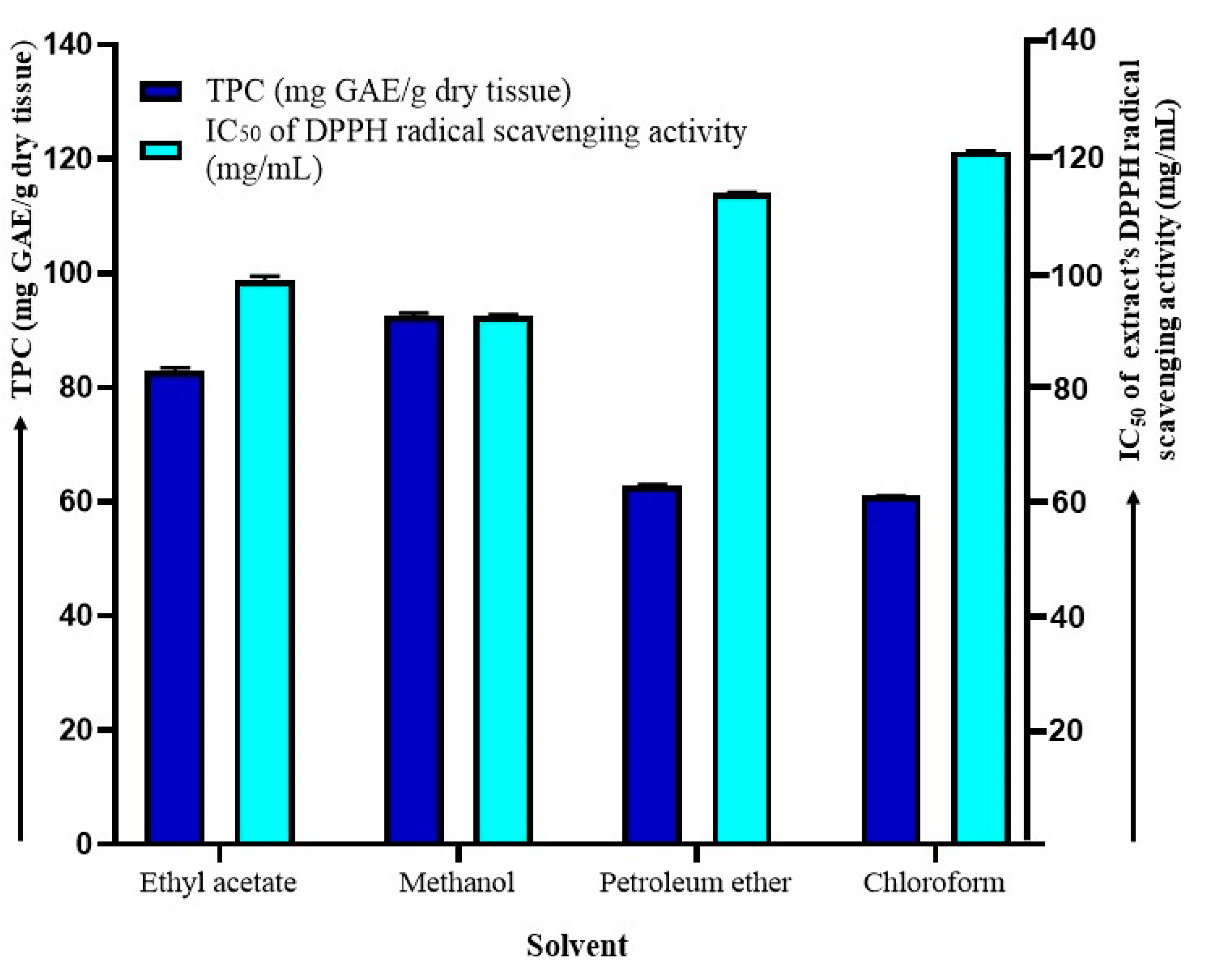
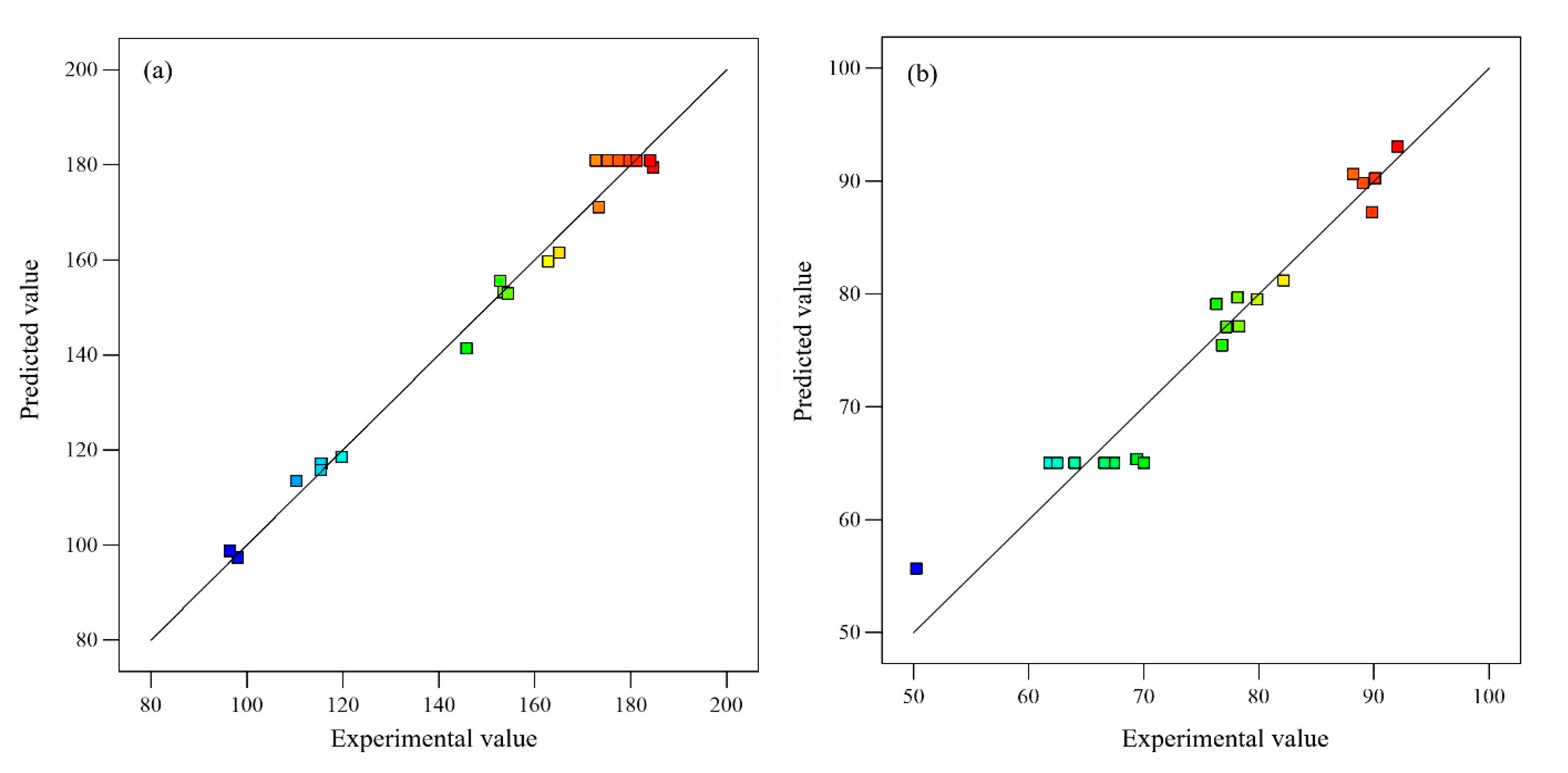
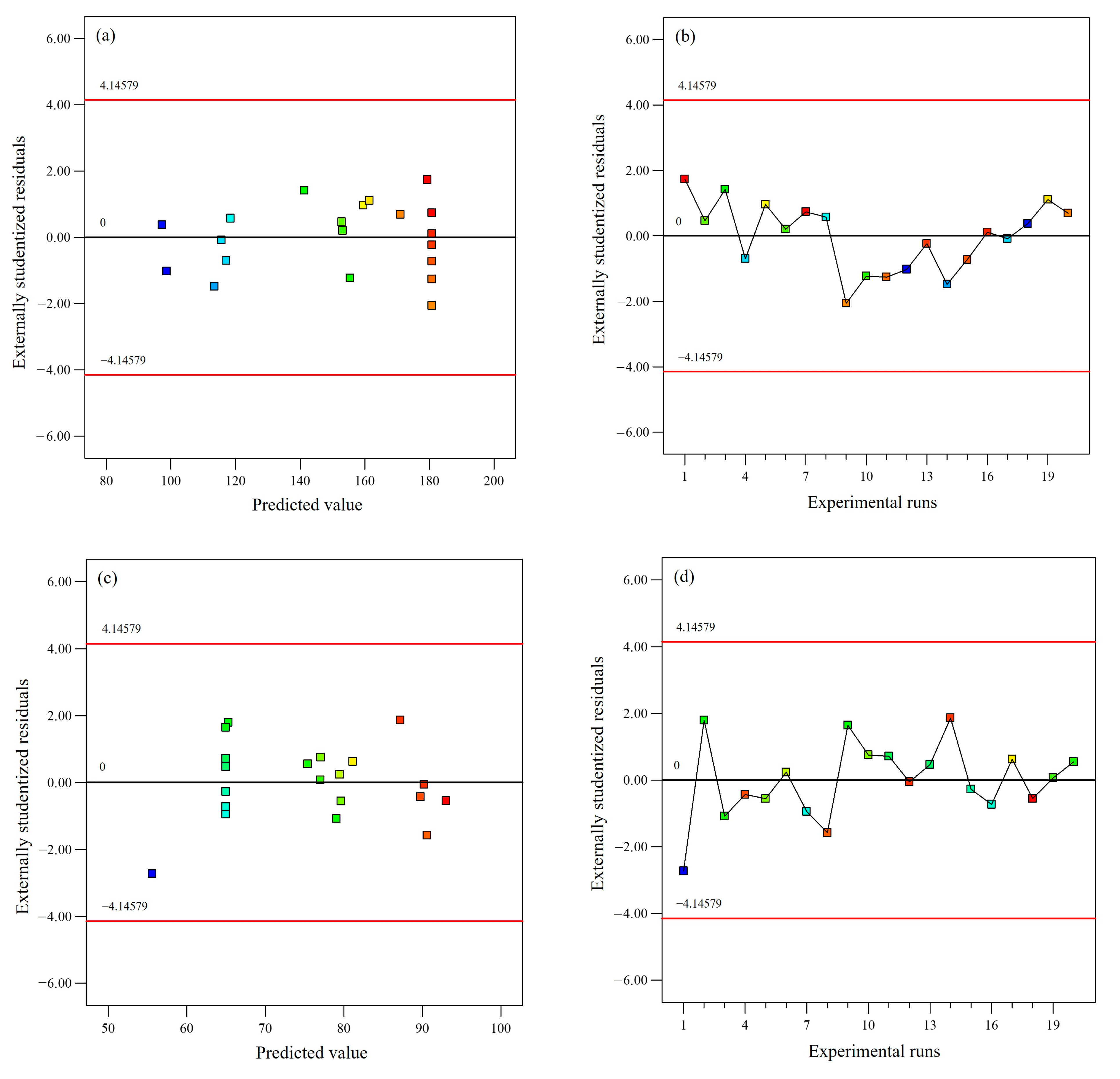
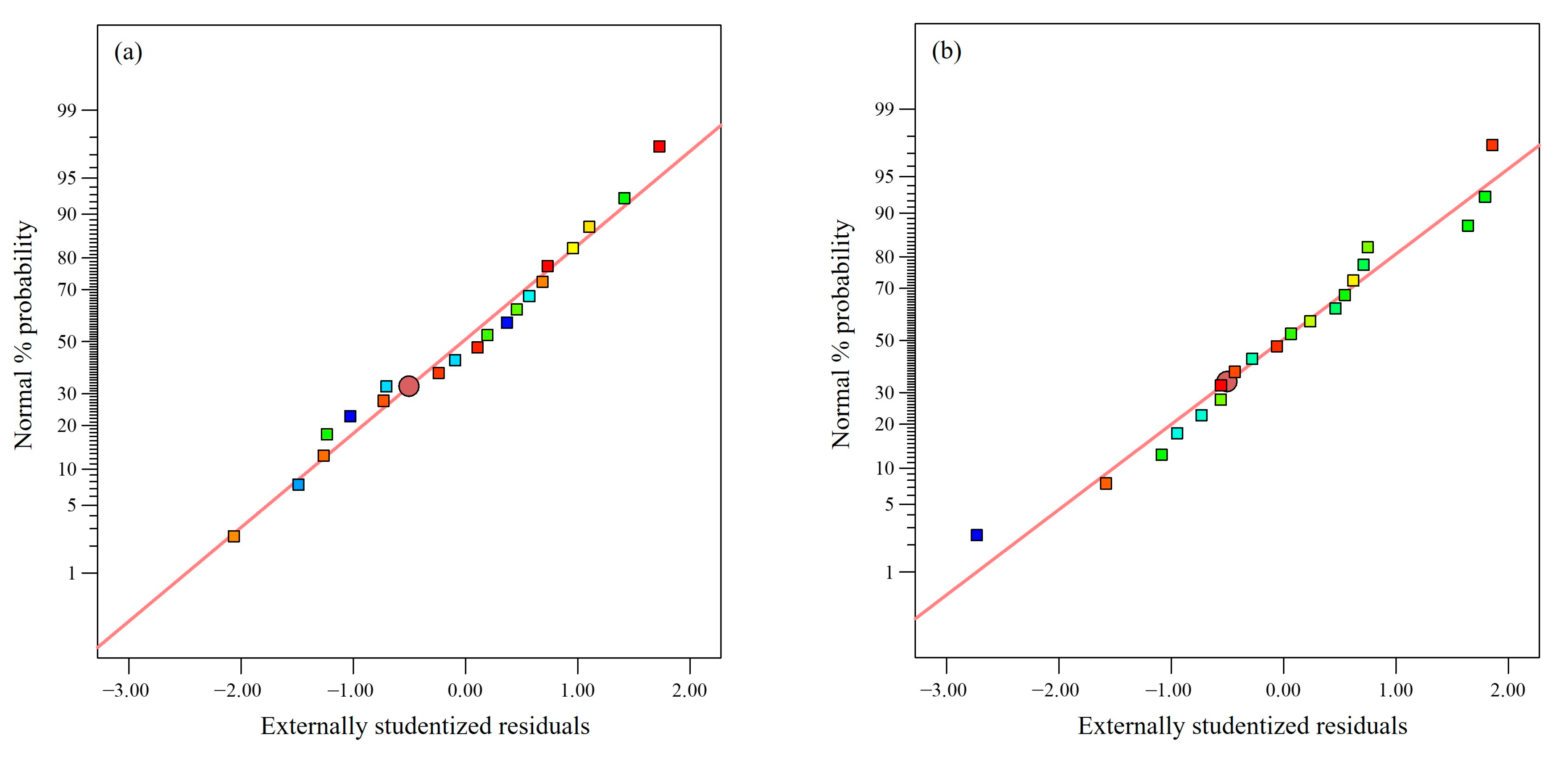
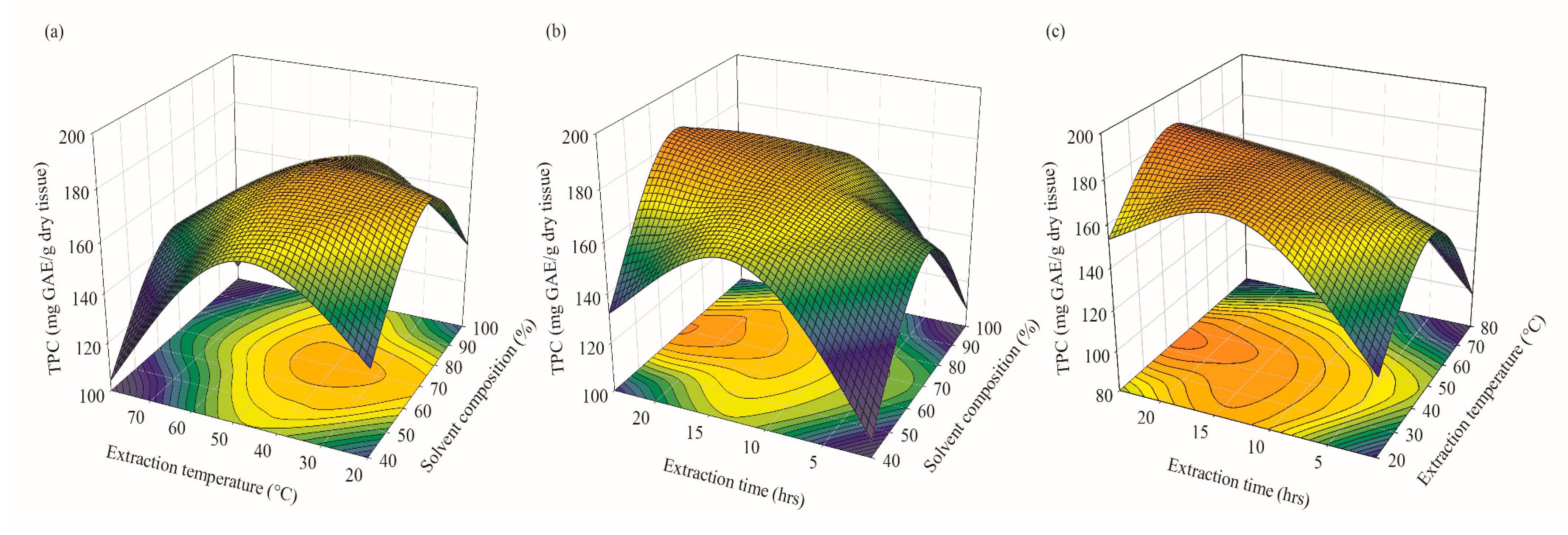
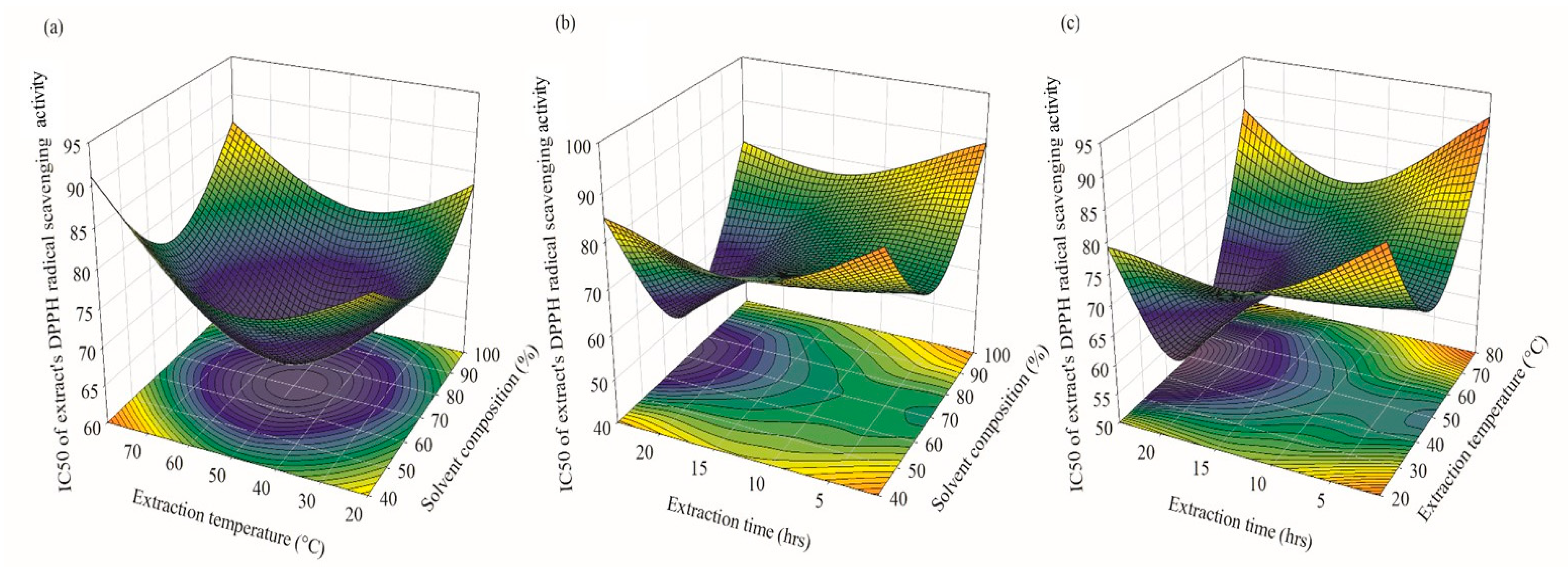
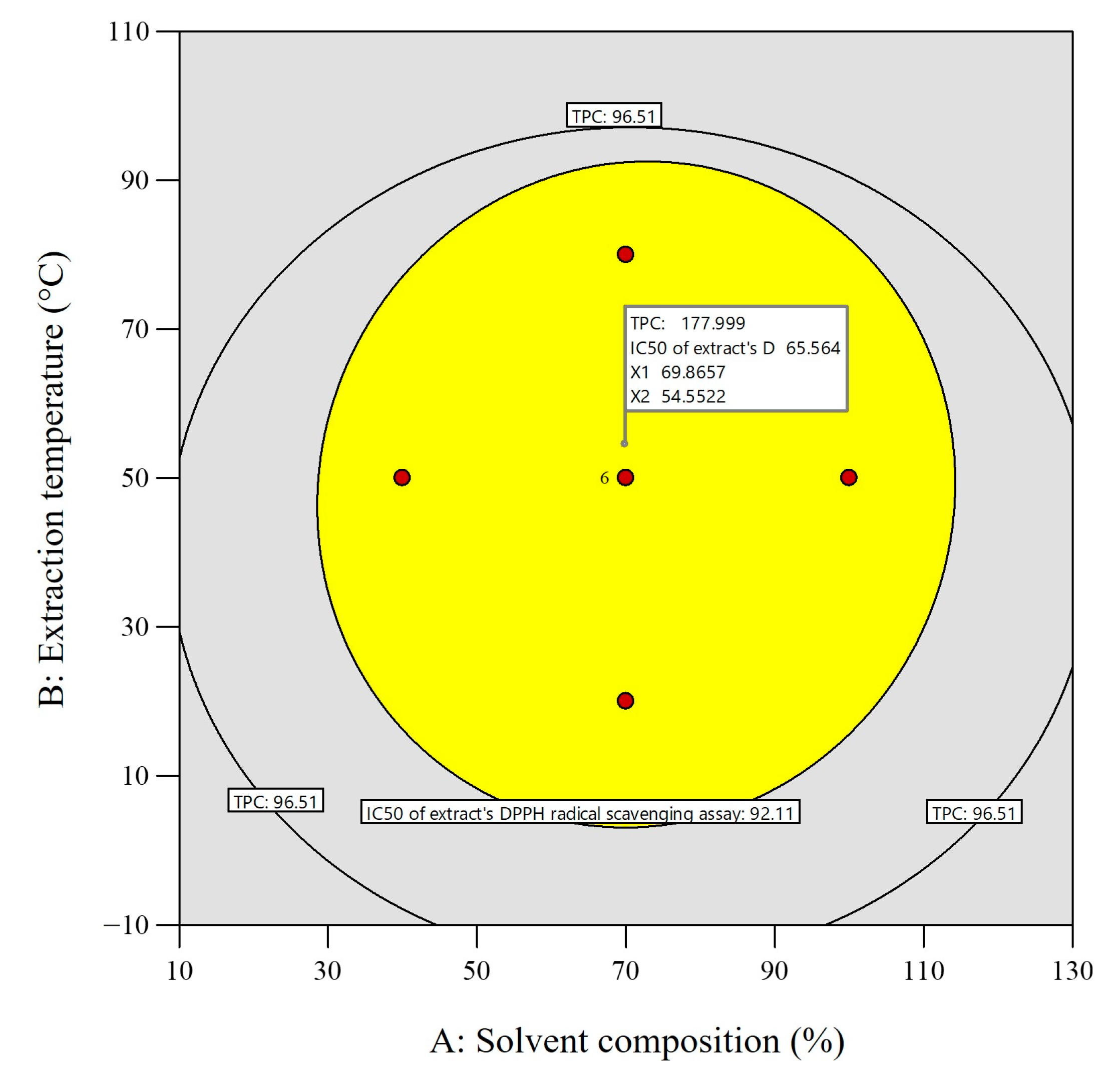
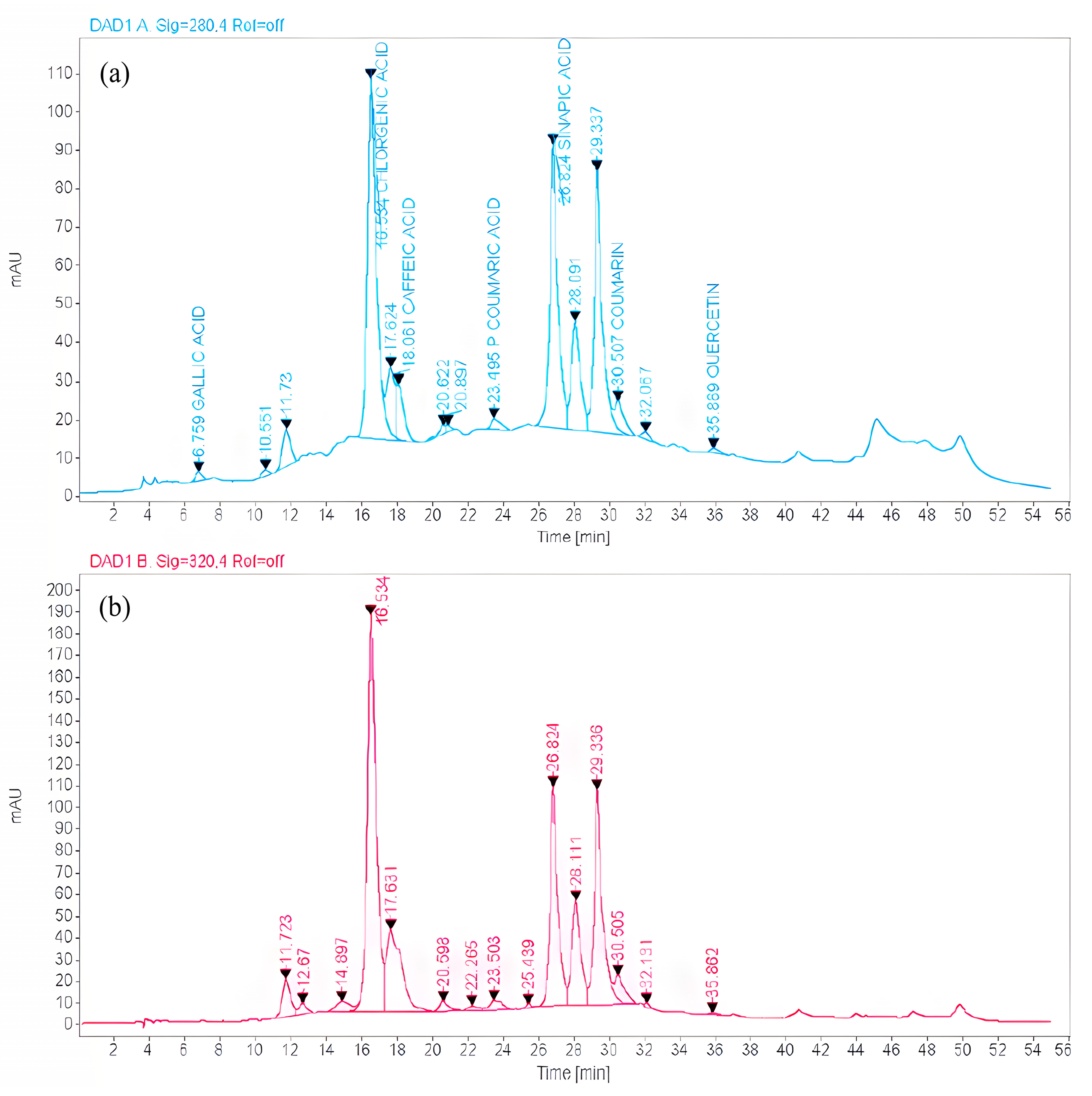
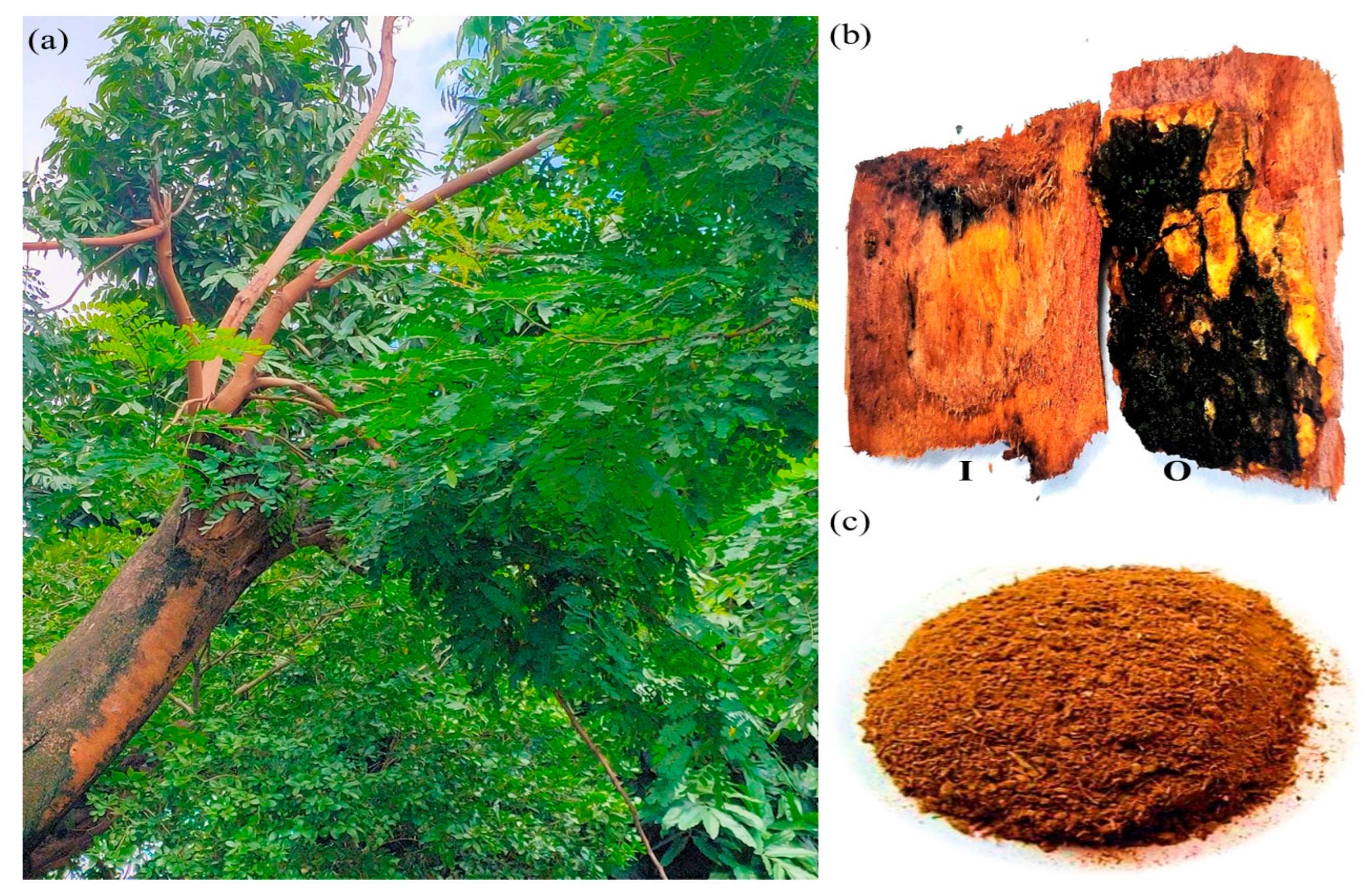
| Run | Independent Parameters | Response Variables (y1 and y2) | |||||
|---|---|---|---|---|---|---|---|
| x1 * | x2 ** | x3 *** | Experimental Value | Predicted Value | |||
| TPC (mg GAE/g Dry Tissue) | IC50 of Extract’s DPPH Radical Scavenging Activity (mg/mL) | TPC (mg GAE/g Dry Tissue) | IC50 of Extract’s DPPH Radical Scavenging Activity (mg/mL) | ||||
| 1 | 40 | 20 | 1 | 115.54 ± 0.43 | 89.07±0.27 | 117.09 | 89.79 |
| 2 | 100 | 20 | 1 | 119.78 ± 0.42 | 88.25 ± 0.15 | 118.5 | 90.62 |
| 3 | 40 | 80 | 1 | 98.16 ± 0.71 | 92.11 ± 0.03 | 97.32 | 93.03 |
| 4 | 100 | 80 | 1 | 96.51 ± 0.036 | 90.14 ± 0.04 | 98.71 | 90.23 |
| 5 | 40 | 20 | 24 | 154.64 ± 0.39 | 79.91 ± 0.23 | 153.18 | 79.5 |
| 6 | 100 | 20 | 24 | 152.89 ± 0.11 | 78.33 ± 0.06 | 155.48 | 77.09 |
| 7 | 40 | 80 | 24 | 110.43 ± 0.30 | 89.89 ± 0.20 | 113.45 | 87.2 |
| 8 | 100 | 80 | 24 | 115.52 ± 0.41 | 82.2 ± 0.19 | 115.72 | 81.16 |
| 9 | 40 | 50 | 12.5 | 162.89 ± 0.15 | 78.2 ± 0.25 | 159.62 | 79.65 |
| 10 | 100 | 50 | 12.5 | 165.17 ± 0.16 | 77.23 ± 0.24 | 161.46 | 77.05 |
| 11 | 70 | 20 | 12.5 | 173.44 ± 0.13 | 76.85 ± 0.14 | 171.04 | 75.42 |
| 12 | 70 | 80 | 12.5 | 145.85 ± 0.10 | 76.35 ± 0.20 | 141.28 | 79.07 |
| 13 | 70 | 50 | 1 | 154.49 ± 0.07 | 69.43 ± 0.43 | 152.86 | 65.32 |
| 14 | 70 | 50 | 24 | 184.76 ± 0.02 | 50.26 ± 0.08 | 179.41 | 55.64 |
| 15 | 70 | 50 | 12.5 | 175.38 ± 0.16 | 67.44 ± 0.10 | 180.83 | 65 |
| 16 | 70 | 50 | 12.5 | 179.73 ± 0.22 | 66.62 ± 0.12 | 180.83 | 65 |
| 17 | 70 | 50 | 12.5 | 184.18 ± 0.20 | 61.83 ± 0.13 | 180.83 | 65 |
| 18 | 70 | 50 | 12.5 | 181.35 ± 0.18 | 62.52 ± 0.10 | 180.83 | 65 |
| 19 | 70 | 50 | 12.5 | 172.87 ± 0.43 | 70.06 ± 0.04 | 180.83 | 65 |
| 20 | 70 | 50 | 12.5 | 177.53 ± 0.41 | 64.04 ± 0.085 | 180.83 | 65 |
| Source | SS 1 | df 2 | MS 3 | F-Value | p-Value | |
|---|---|---|---|---|---|---|
| Model | 17,332.16 | 9 | 1925.80 | 85.75 | <0.0001 | significant |
| x1 * | 8.48 | 1 | 8.48 | 0.3777 | 0.5526 | |
| x2 ** | 2214.74 | 1 | 2214.74 | 98.62 | <0.0001 | significant |
| x3 *** | 1762.52 | 1 | 1762.52 | 78.48 | <0.0001 | significant |
| x1² | 1131.78 | 1 | 1131.78 | 50.39 | <0.0001 | significant |
| x2² | 1673.92 | 1 | 1673.92 | 74.53 | <0.0001 | significant |
| x3² | 593.59 | 1 | 593.59 | 26.43 | 0.0004 | significant |
| x1x2 | 0.0003 | 1 | 0.0003 | 0.0000 | 0.9971 | |
| x1x3 | 0.3828 | 1 | 0.3828 | 0.0170 | 0.8987 | |
| x2x3 | 199.30 | 1 | 199.30 | 8.87 | 0.0138 | significant |
| Residual | 224.58 | 10 | 22.46 | |||
| Lack of Fit | 140.31 | 5 | 28.06 | 1.67 | 0.2947 | not significant |
| Pure Error | 84.27 | 5 | 16.85 | |||
| R2 | 0.98 | |||||
| Adjusted R2 | 0.97 | |||||
| Predicted R2 | 0.93 | |||||
| Adequate precision | 24.92 |
| Source | SS 1 | df 2 | MS 3 | F-Value | p-Value | |
|---|---|---|---|---|---|---|
| Model | 2337.24 | 9 | 259.69 | 20.66 | <0.0001 | significant |
| x1 * | 16.98 | 1 | 16.98 | 1.35 | 0.2721 | |
| x2 ** | 33.42 | 1 | 33.42 | 2.66 | 0.1340 | |
| x3 *** | 234.35 | 1 | 234.35 | 18.65 | 0.0015 | significant |
| x1² | 490.28 | 1 | 490.28 | 39.01 | <0.0001 | significant |
| x2² | 412.49 | 1 | 412.49 | 32.82 | 0.0002 | significant |
| x3² | 56.13 | 1 | 56.13 | 4.47 | 0.0607 | |
| x1x2 | 6.59 | 1 | 6.59 | 0.5242 | 0.4856 | |
| x1x3 | 5.25 | 1 | 5.25 | 0.4176 | 0.5327 | |
| x2x3 | 9.95 | 1 | 9.95 | 0.7914 | 0.3946 | |
| Residual | 125.68 | 10 | 12.57 | |||
| Lack of Fit | 75.50 | 5 | 15.10 | 1.50 | 0.3325 | not significant |
| Pure Error | 50.18 | 5 | 10.04 | |||
| R2 | 0.94 | |||||
| Adjusted R2 | 0.90 | |||||
| Predicted R2 | 0.72 | |||||
| Adequate precision | 14.92 |
| Parameters | Optimum Conditions | Predicted Values | Experimental Values | 95% Confidence Interval | |||||
|---|---|---|---|---|---|---|---|---|---|
| Low | High | ||||||||
| TPC (mg GAE/g Dry Tissue) | IC50 of Extract’s DPPH Radical Scavenging Activity (mg/mL) | TPC (mg GAE/g Dry Tissue) | IC50 of Extract’s DPPH Radical Scavenging Activity (mg/mL) | TPC (mg GAE/g Dry Tissue) | IC50 of Extract’s DPPH Radical Scavenging Activity (mg/mL) | TPC (mg GAE/g Dry Tissue) | IC50 of Extract’s DPPH Radical Scavenging Activity (mg/mL) | ||
| x1 * | 71.61 | 182.84 | 55.62 | 181.69 ± 0.20 | 60.13 ± 0.11 | 175.49 | 50.11 | 190.18 | 74.62 |
| x2 ** | 42.52 | ||||||||
| x3 *** | 24.00 | ||||||||
| Sl. No | Name of the Compound | Amount (mg/g Dry Tissue) | Chemical Group | Biological Activity |
|---|---|---|---|---|
| 1 | Gallic acid | 0.042 | Phenolic acid | Anti-inflammatory, antioxidant, anticancerous, antimicrobial [47,48] |
| 2 | Chlorogenic acid | 117.526 | Phenolic acid | Antioxidant, anti-inflammatory, anticancerous, antimicrobial [45] |
| 3 | Caffeic acid | 5.809 | Phenolic acid | Anti-inflammatory, antioxidant, antimicrobial, analgesic, and cardioprotective [49] |
| 4 | p-coumaric acid | 0.487 | Phenolic acid | Anti-inflammatory, antioxidant, antineoplastic, and antimicrobial [50] |
| 5 | Sinapic acid | 64.779 | Phenolic acid | Anti-inflammatory, antioxidant, anticancerous, and antimicrobial. [46] |
| 6 | Coumarin | 1.523 | Coumarins (benzopyrone) | Antimicrobial, antioxidant, anti-inflammatory, anticancer, anti-TB, and anticonvulsant [51,52] |
| Symbols | Independent Variables | Unit | Coded Levels | ||
|---|---|---|---|---|---|
| −1 (Low) | 0 (Medium) | +1 (High) | |||
| x1 | Solvent composition (% v/v of methanol/water) | % | 40 | 70 | 100 |
| x2 | Extraction temperature | °C | 20 | 50 | 60 |
| x3 | Extraction time | h | 1 | 12.5 | 24 |
| Dependent/Response Variables | Goal | ||||
| y1 | Total phenolic content | mg GAE/g dry tissue | Maximize | ||
| y2 | IC50 of extract’s DPPH radical scavenging activity | (mg/mL) | Maximize | ||
Disclaimer/Publisher’s Note: The statements, opinions and data contained in all publications are solely those of the individual author(s) and contributor(s) and not of MDPI and/or the editor(s). MDPI and/or the editor(s) disclaim responsibility for any injury to people or property resulting from any ideas, methods, instructions or products referred to in the content. |
© 2023 by the authors. Licensee MDPI, Basel, Switzerland. This article is an open access article distributed under the terms and conditions of the Creative Commons Attribution (CC BY) license (https://creativecommons.org/licenses/by/4.0/).
Share and Cite
Begum, S.N.; Hossain, M.; Adnan, M.; Rahaman, C.H.; Reza, A. Optimization and Characterization of Phenolic Extraction Conditions and Antioxidant Activity Evaluation of Adenanthera pavonina L. Bark. Plants 2023, 12, 3902. https://doi.org/10.3390/plants12223902
Begum SN, Hossain M, Adnan M, Rahaman CH, Reza A. Optimization and Characterization of Phenolic Extraction Conditions and Antioxidant Activity Evaluation of Adenanthera pavonina L. Bark. Plants. 2023; 12(22):3902. https://doi.org/10.3390/plants12223902
Chicago/Turabian StyleBegum, Syeda Nurunnesa, Mobarok Hossain, Md. Adnan, Chowdhury Habibur Rahaman, and Arif Reza. 2023. "Optimization and Characterization of Phenolic Extraction Conditions and Antioxidant Activity Evaluation of Adenanthera pavonina L. Bark" Plants 12, no. 22: 3902. https://doi.org/10.3390/plants12223902
APA StyleBegum, S. N., Hossain, M., Adnan, M., Rahaman, C. H., & Reza, A. (2023). Optimization and Characterization of Phenolic Extraction Conditions and Antioxidant Activity Evaluation of Adenanthera pavonina L. Bark. Plants, 12(22), 3902. https://doi.org/10.3390/plants12223902










